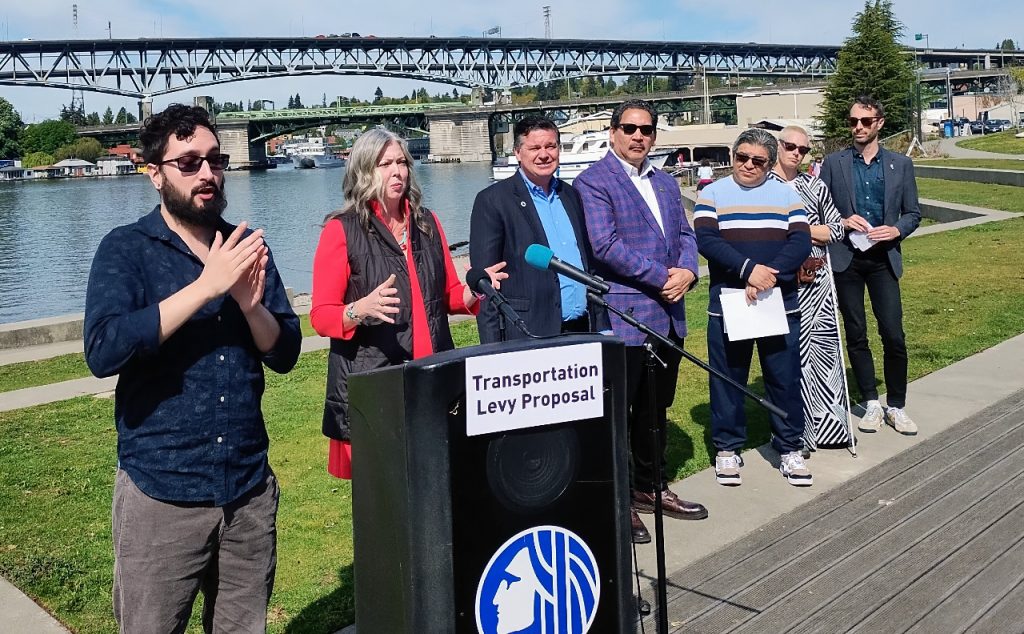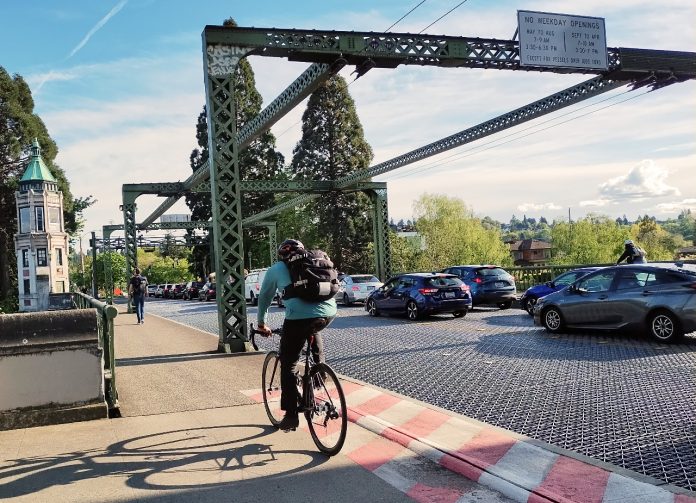
On Friday, Mayor Bruce Harrell announced an extra $100 million in funding focused on sidewalks, protected bike lanes, and transit in his proposed eight-year transportation levy, increasing the grand total to $1.45 billion. The package announced in early April had come in at $1.35 billion, but after soliciting public feedback on the proposal, Harrell revised it upward with an extra $12.5 million per year — an 7.5% increase.
The boost responds to calls for the levy to accelerate the pace of transportation investments, as the initial proposal essentially only kept spending equal with the $930 million Move Seattle Levy (passed in 2015) after accounting for inflation. The City is highly reliant on levy funding, as Move Seattle accounts for about 30% of the overall budget at the Seattle Department of Transportation (SDOT).
Advocates, including a coalition made up of groups like Seattle Neighborhood Greenways, Disability Rights Washington, the Transit Riders Union, and The Urbanist have been pushing for the levy to be at least 50% comprised of multimodal investments rather than those focused on single-occupancy vehicles. They’ve pointed to polling showing voters support a larger $1.7 billion levy with multimodal emphasis. [Note: The Urbanist’s advocacy staff and volunteers participate in coalitions independently of our editorial team.]
However, the mayor’s first draft was heavily weighted toward road and bridge maintenance, with close to $650 million earmarked for those two areas.
This second draft gets closer to the advocates’ 50% goal, with the most notable change compared to the April draft a commitment to build 250 blocks of sidewalks by 2028, originally the commitment for the full eight years. That will be possible with an additional $20 million in direct sidewalk funding, with an additional $5 million provided for a new transportation funding task force to look at new sources of revenue to complete the city’s missing sidewalk network much more substantially. That task force aligns with the official recommendation from the Move Seattle levy’s oversight committee, which called for the city to look beyond its property tax levy for sources of transportation funding.
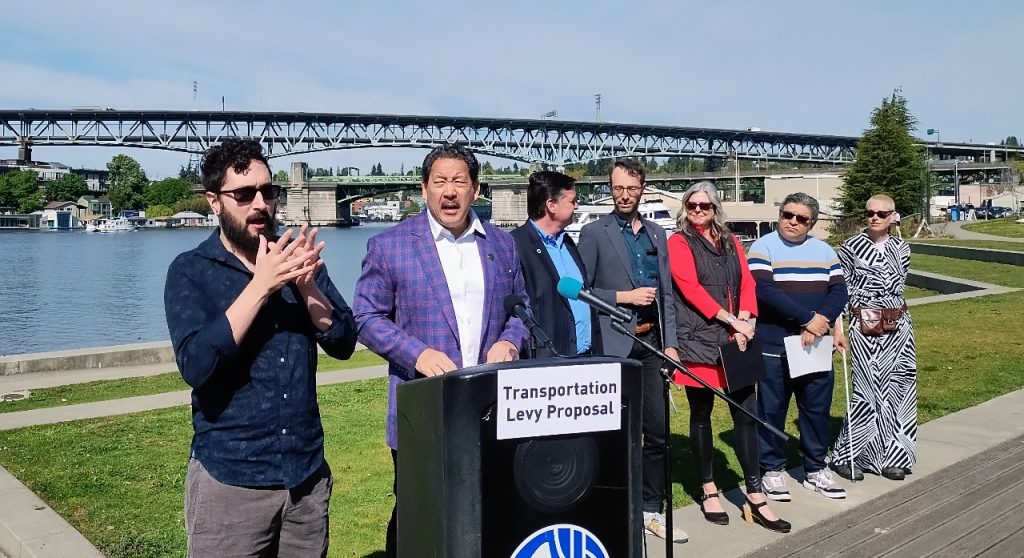
Mayor Harrell presented his levy proposal as one that provides something for everyone.
“Our focus from day one on the levy process was to create a package that invests in the essential needs of our communities, and creates a safe and welcoming, reliable transportation system,” Harrell said. “It’s to build a consensus across communities that historically can be at odds with one another, thinking about [how] their priority should be in front of another — particularly advocacy groups. That’s not a One Seattle approach to how we approach transportation.”
Along with the additional $26 million for pedestrian programs, $20 million would be added to fund transit improvement projects, with an additional $3 million intended to improve rider security and safety on the existing bus system. An additional $5 million would fund expanded pedestrian lighting throughout the city, and $6 million would fund work on a proposed “Occidental Promenade,” a project identified as part of work to create an improved neighborhood around Seattle’s sports stadiums. Like the nearby Railroad Way project, the Occidental Promenade would be open to vehicle traffic outside event days but closed like a festival street at times of high use.
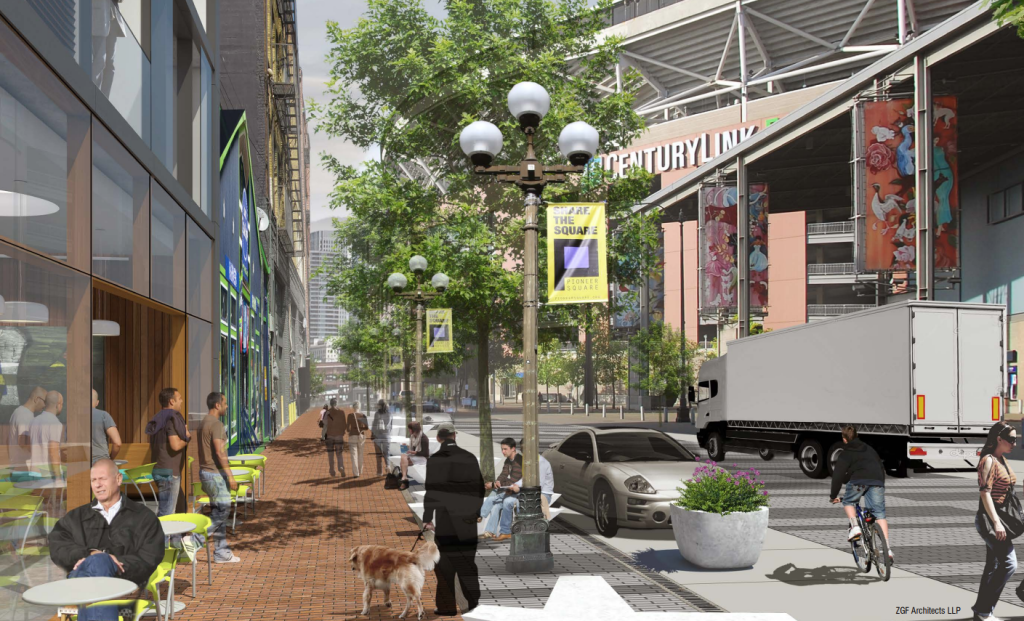
The city’s existing community-prompted Neighborhood Street Fund program would be reorganized into a new “Neighborhood-Initiated Safety Partnership Program” with $41 million in funding, along with a new $14 million for safety projects to be advanced at the council district level. An additional $3 million would go toward bridge maintenance funding, and $10 million would fund Seattle City Light’s work to expand electric vehicle charging infrastructure in the public right-of-way.
Another $20 million was added in bike infrastructure funding, though the levy still lacks any concrete goal around how exactly that funding will be used.
Mayor Harrell pointed to Seattle’s district council system, brand new when the 2015 Move Seattle levy was approved, as prompting the need for the next levy to have fewer prescriptive targets. “I expect each of the seven district council members to know their district, inside and out,” Harrell said. “So we wanted to bake in a little flexibility for the city councilors to know their sidewalks, their streets, their cycle networks, to be able to have that communication… so that is a significant change in how we make political and investment decisions.”
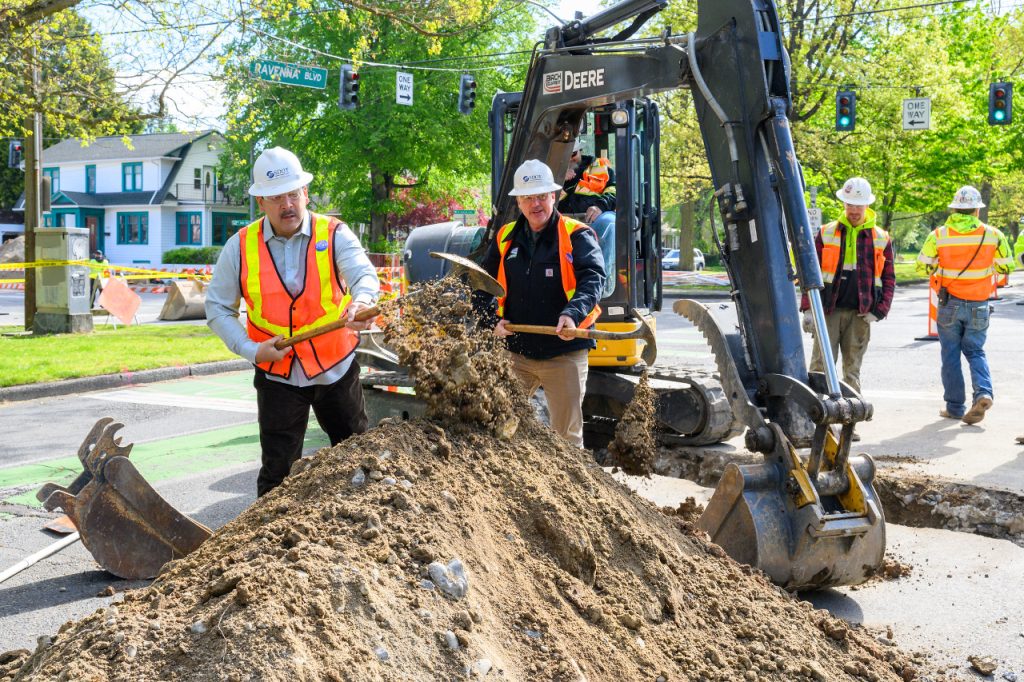
Harrell also pointed to the need to be data-driven as another reason to not set clear expectations now. “We had to bake in a little bit of flexibility because we continue to gather data on where our high risk areas are,” he said. “And so we continue to work on this levy, even how we govern it during its eight year course, it has to be some[what] fluid.”
In 2015, when Move Seattle garnered a “no” recommendation from the Seattle Times Editorial Board, the lack of specificity was cited as a primary reason, with the board calling the proposal a “grab-bag of diffuse spending.” Harrell’s “transportation levy proposal” — still without a flashy name — is inarguably less specific than that package, though its exact guardrails are yet to be set by the ordinance sending it to the voters.
Notably, no city councilmembers were present at Friday’s announcement, a change from past levy announcements even during Mayor Harrell’s tenure. But the city’s business establishment was represented in the form of Rachel Smith, the CEO and President of the Seattle Metropolitan Chamber of Commerce herself a former government and community relations officer for Sound Transit and field director at Transportation Choices Coalition.
“The punch line is that the levy is important,” Smith said Friday. “The right stakeholder and voter priorities are reflected, and we look forward to working with the Seattle City Council as it considers this proposal. Investing in transportation adds to our region’s prosperity, and prosperity is a good thing. We just need to make sure everyone has access to it.”
In a conversation with The Urbanist toward the end of the comment period on the levy, SDOT Director Greg Spotts outlined what the department had been hearing about the initial draft.
“[I’m] hearing a lot of excitement about the neighborhood level investments, this bucket of almost $100 million for neighborhood level investments,” Spotts said. “And there’s like multiple types of folks who are interested in that: there’s people who are spending more time in their neighborhood because of hybrid work, who want like safe routes to my everything. Because they’re not just doing a backbreaking commute five days a week. There’s underserved communities who really want us to be in relation with them over the long term, to have like a multi-year plan for urban acupuncture to make it like safer and more pleasant to walk and bike and use transit in their neighborhood.”
Spotts also mentioned Seattle residents who cited the condition of the city’s bridges as a top concern, following the emergency closure of the West Seattle Bridge from 2020 to 2022. And he heard from Seattleites who want to see the city’s bike network fill in its missing gaps, a push that seems to be behind the additional $20 million announced this month.
“I would also say, there’s broad support for building a protected bike lane network in the South End, that is as good as what we have, like, north of Jackson [Street],” Spotts said. “We have a really good network in the downtown, and a very nice network north of the ship canal, And there’s a broad belief that it’s time to do that in the south as well.”
The Seattle City Council’s select committee on the levy, which will have all nine members on it, is meeting this upcoming Tuesday to get its first real look at the proposal as a group. Their deadline to send the package to the voters is this summer, with the next two months representing the most substantive task that the new city council, made up of six brand new members, has been asked to do.
“We have an incredible opportunity right now to roll up our sleeves and build a better future for Seattle,” transportation committee chair Rob Saka, who will be heading up the select committee, said following Harrell’s announcement Friday. “Building and maintaining bridges, roads, sidewalks, bike lanes, and busses may seem like the boring work of government, but few things shape the way we interact with our city and connect with each other more.”
Ryan Packer has been writing for The Urbanist since 2015, and currently reports full-time as Contributing Editor. Their beats are transportation, land use, public space, traffic safety, and obscure community meetings. Packer has also reported for other regional outlets including BikePortland, Seattle Met, and PubliCola. They live in the Capitol Hill neighborhood of Seattle.

